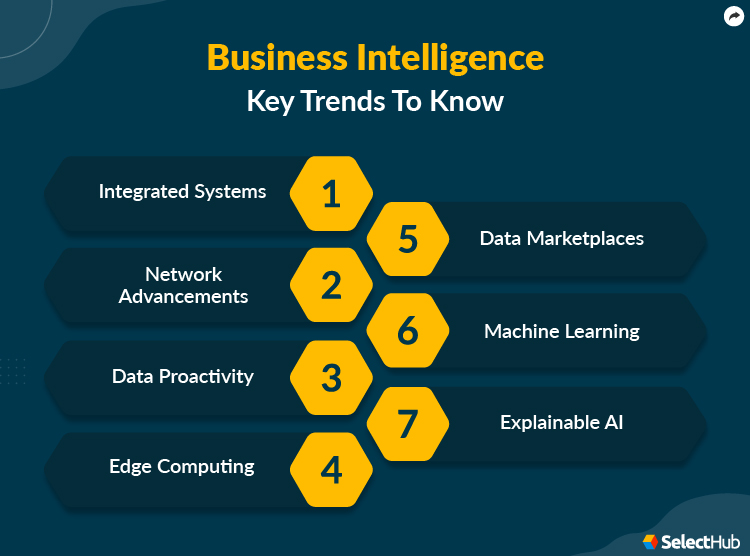Emerging Trends in Business Analytics for the Future, Beyond 2023

Business analytics trends encompass the evolving methodologies, technologies, and strategies organisations employ to extract valuable insights from data. In an era marked by an exponential increase in data generation, businesses continually seek innovative ways to leverage this information for informed decision-making, enhanced operational efficiency, and sustainable growth. Our article delves into these dynamic trends, shedding light on the latest developments shaping the field of business analytics.
The relevance of these trends extends far beyond the year 2023. In a fast-paced, digitally-driven world, data-driven decision-making is becoming increasingly indispensable. The trends we discuss have the potential to revolutionize how businesses operate and compete. They enable organizations to adapt to changing market dynamics, identify opportunities and risks, and enhance customer experiences.
Beyond 2023, these trends will continue to drive business innovation, fostering a data-centric culture that survives and thrives in an increasingly competitive landscape. Staying informed about these trends is critical for businesses to remain agile, competitive, and future-ready in the years to come. Pursuing a business analytics course can be a stepping stone in remaining ahead of the developments.
A transformative landscape driven by data characterizes the present state of business analytics. Organizations across industries harness data’s power to gain deeper insights, make data-informed decisions, and gain a competitive edge. Business analytics today encompasses a broad spectrum of technologies and methodologies:
At the core of business analytics are robust data collection and storage systems. Data is collected from various sources, including customer interactions, sales transactions, social media, and IoT devices. Advanced data warehousing and cloud-based solutions facilitate the storage and management of vast datasets.
Analytical tools and techniques, including predictive analytics, machine learning, and artificial intelligence, extract meaningful patterns, correlations, and predictions from data. These insights drive strategic decisions, optimize processes, and enhance customer experiences.
Data visualization tools make complex data more accessible and understandable. Interactive dashboards and reports enable stakeholders to grasp insights quickly.
The importance of staying updated in business analytics cannot be overstated. Organizations that cannot keep pace risk falling behind as the landscape evolves rapidly. Staying updated allows businesses to leverage the latest technologies and methodologies, gain a competitive advantage, and make data-driven decisions that drive growth and innovation. Moreover, it effectively helps organizations address emerging challenges, such as data privacy and security concerns.
Latest developments in Business Analytics
In its ever-evolving nature, business analytics continues to see groundbreaking developments and innovations shaping how organizations operate and make decisions. As we delve into the latest trends, it becomes evident that the landscape of business analytics is undergoing significant transformation:
Predictive Analytics Advancements
Predictive analytics is experiencing remarkable advancements. Beyond traditional forecasting, it now incorporates machine learning algorithms that can analyze historical data to make highly accurate predictions about future events. This has vast applications, from sales forecasting to inventory management. Organizations can optimize their strategies and resources based on these predictive insights, improving efficiency and profitability.
AI and Machine Learning Integration
AI and ML are becoming integral to business analytics. These technologies can process enormous datasets at speeds beyond human capability, uncovering patterns and trends that were previously hidden. Businesses increasingly leverage AI-driven insights for customer segmentation, personalized marketing, fraud detection, and even predictive maintenance in manufacturing. As AI and ML models become more sophisticated, their role in decision-making becomes more prominent.
Big Data Utilization
The utilization of big data is a continued trend in business analytics. Organizations are investing in robust data infrastructure and technologies with the exponential growth of data from various sources. This includes distributed computing frameworks like Hadoop and cloud-based data storage solutions. Big data analytics enables organizations to gain deeper insights from unstructured and semi-structured data, providing a holistic view of their operations and customer behavior.
Data Privacy and Security Concerns
Amidst the data-driven revolution, data privacy and security concerns have gained prominence. With regulatory frameworks such as CCPA and GDPR, organizations are under increased scrutiny to protect customer data. Business analytics trends include investments in data encryption, secure access controls, and compliance measures. Businesses must balance the need for data-driven decision-making with the imperative to safeguard sensitive information.
Visualization and Reporting Tools
Data communication is crucial, and visualization and reporting tools are evolving to meet this demand. Data visualization tools like Tableau and Power BI enable organizations to create interactive and intuitive dashboards. These tools facilitate data exploration and storytelling, making it easier for stakeholders to grasp insights quickly. Advanced reporting tools also incorporate natural language processing, enabling users to query data in plain language.
The emerging trends in business analytics hold substantial potential benefits for organizations. Predictive analytics advancements enable proactive decision-making, while AI and machine learning integration automate processes and enhance customer experiences. Leveraging big data allows for deeper insights into customer behavior and market trends, refining marketing strategies and optimizing operations. However, these trends also present challenges and opportunities.
Data privacy and security concerns necessitate careful compliance with regulations, while a talent shortage for data-related roles calls for investment in recruitment and development. Implementing these trends can be complex and costly, requiring strategic planning. Failing to embrace them may result in losing competitive ground. Overall, businesses must navigate these challenges to leverage the opportunities presented by the evolving business analytics landscape, ensuring they remain competitive and data-driven in today’s market.
Conclusion
In today’s business landscape, data is abundant. A business analytics course equips individuals with the skills to collect, analyze, and interpret data effectively. This enables data-driven decision-making, leading to more informed and strategic choices. Businesses that leverage data analytics gain a competitive edge. Understanding how to extract insights from data helps organizations identify opportunities, optimize processes, and mitigate risks, ultimately improving their competitive position.
A business analytics course is essential in today’s data-driven world. It empowers individuals and organizations to harness the power of data for better decision-making, increased efficiency, and competitive advantage. As businesses continue to rely on data for growth and innovation, the importance of business analytics skills will only continue to grow.






